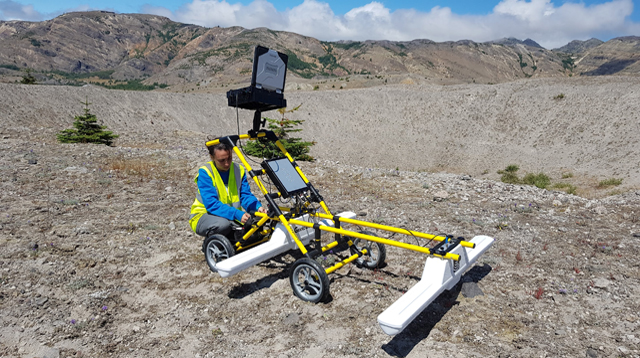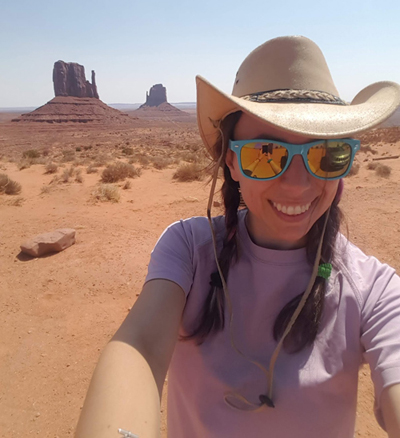22 May 2023–Simona Gabrielli studies seismic attenuation, or what happens when a seismic wave interacts with its surrounding medium. She compares it to how a stone dropped into a pond sends ripples through the water, and the ripples change direction depending on what they meet as they move across the pond.
In the case of seismic waves, “it could be magma, if we are in a volcanic setting, or faults in the Earth, and from there we obtain a lot of information about what we have under our feet,” said Gabrielli, a postdoctoral researcher at Istituto Nazionale di Geofisica e Vulcanologia (INGV) in Italy.
Her Ph.D. work examined attenuation under Mount St. Helens, looking at correlations between the scattering of seismic waves and the geomorphology of the volcano. It was like getting “two Ph.D.s in one,” she said, to learn both about attenuation and to map the volcanic underbelly.

Her strength as a researcher, she said, is her ability to do a good interpretation of the geological setting of seismic activity. “When I review papers, I sometimes see that geophysicists leave out the interpretation, but we have to try to combine those two things, and not keep them separated, for the best results.”
She is now working in the central Appenines mountains of Italy, using the techniques she learned with Mount St. Helens to understand more about deformation in this earthquake-prone region. It’s something of a homecoming for Gabrielli. She grew up in central Italy on the coast, with an early fascination with the natural world. As a child she brought home buckets of beach stones and shells—much to her mother’s dismay, she said.
She remembers many earthquakes near the towns of Amatrice, Norcia and L’Aquila, where she had friends, and always wanted to get back to study the region.
“The seismicity in this area of Italy is always considered as normal extension, normal faults,” Gabrielli explained. With her new research, however, “we see that the thrusts, the inverse movements are also having quite an important role in tectonic behavior in central Italy.”
Her work also confirms the role of subsurface fluids in the area “that are moving in the fault network and triggering these mainshocks,” she said. “But the origin of this fluid is still not clear at all.”
Despite recent earthquakes in the region that have been deadly and damaging, Gabrielli said there is still an urgent need for geological education in Italy, to make people aware of seismic risks and to prevent problems like building structures from materials that collapsed in earlier earthquakes.
“In a country like Italy where you know that probably every 10 years you will have these kinds of big earthquakes, and you still don’t understand that you need to build properly, it means there is a lack of education,” she said.
 Writing is one way that Gabrielli hopes to engage with more people about the importance of geology and seismology. She is a blogger for the European Geosciences Union’s Geochemistry, Mineralogy, Petrology & Volcanology division. While some of her posts are devoted to discussing new science, she also delves into topics like the geology in fantasy novels (what kind of volcano is Mount Doom, anyway?).
Writing is one way that Gabrielli hopes to engage with more people about the importance of geology and seismology. She is a blogger for the European Geosciences Union’s Geochemistry, Mineralogy, Petrology & Volcanology division. While some of her posts are devoted to discussing new science, she also delves into topics like the geology in fantasy novels (what kind of volcano is Mount Doom, anyway?).
“I try to explain or introduce geology or simple things about geology and how they influence our daily lives,” she said. “Like the minerals in famous paintings, or the connection between volcanoes and wine.”
As she nears the end of her postdoc, Gabrielli is considering the next steps in her career. She loves her great colleagues and ability to research across a wide range of topics at INGV, but misses the connection with students in an academic setting. She would like to remain in research, but she also has a master’s degree in petroleum geology, so she has thought about looking for a job in industry.
The skills picked up in a seismology career can lead in some unexpected directions, she noted. One week before the Russian invasion of Ukraine in 2022, she was contacted by an agency that was working with satellite images and noted her previous experience in this field. It’s likely that the job was war-related, Gabrielli said, and she didn’t take the offer. “But maybe that industry is another one that I can consider.”
SSA At Work is a monthly column that follows the careers of SSA members. For the full list of issues, head to our At Work page.
